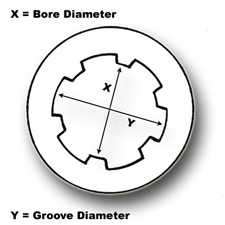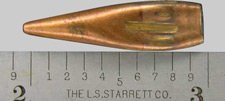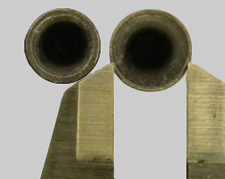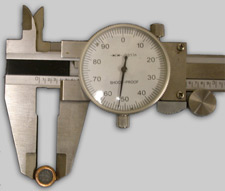- 01: Introduction
- 02: History
- 03: Propellants, Firearms, and Ammunition Development
- 04: Modern Firearms Manufacture
- 05: Small Arms Ammunition
- 06: Evidence Handling Procedures
- 07: Equipment and Instrumentation
- 08: Examination of Firearms
- 09: Cartridge and Shotshell Examination
- 10: Characterization and Evaluation of Fired Projectiles
- 11: Bullet Comparison and Identification
- 12: Gunshot Residue and Distance Determination
- 13: Toolmark Identification
- 14: Communicating Results
- Resources


Caliber/Diameter
Home > Characterization and Evaluation of Fired Projectiles > Physical Features > Caliber/Diameter

Bore and groove diameters
The bore diameter of the barrel of a rifled firearm is defined as the diameter of the circle formed by the tops of the lands inside the barrel. This diameter does not include the grooves within the barrel. However, a portion of the mass of a fired bullet is extruded into these grooves. Therefore, the diameter of a fired bullet will approximate the larger groove diameter and will always be greater than the bore diameter of the firearm.
The measured diameter of fired bullets is taken from one groove impression (a high point on a fired bullet) to a groove impression on the opposite side of the bearing surface. If there are an odd number of groove impressions, the measurement is taken from the edges of a pair of impressions. The base of the bearing surface of a bullet is used because it is generally more protected when a bullet impacts with an object. Often the bearing surface ends at the base of the entire bullet, although with boattailed bullets this would not be the case. For bullets that are severely flattened or distorted, it may be possible to measure the circumference and calculate an approximate diameter.

Significant base mutilation

Deep hollow-based lead bullets, held by calipers.

Calipers
Whenever measurements are taken, avoid damaging or obliterating microscopic marks on the groove impressions with measuring instruments such as calipers. Plastic calipers can minimize this potential problem.
In the following situations, a measurement should be taken at an alternate location:
- Significant base mutilation upon impact, altering the width or apparent caliber
- Unusual amount of base expansion after firing (e.g., deep hollow-based lead bullets)
- Unusual base expansion of lead bullets after firing from a short-barreled handgun




